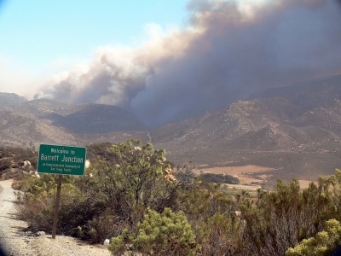
Story and photos by Miriam Raftery
Photo, left: Harris Fire viewed from Barrett Junction, the morning of October 21, 2007
October 21, 2017 (San Diego’s East County) – Ten years ago today, I was among the first reporters on the scene when the devastating 2007 firestorms began. I couldn’t believe that just four years after the deadly Cedar Fire, the nightmare was occurring again –on what turned out to be an even more horrific scale.
Out of the ashes of those fires, East County Magazine and our East County Wildfire and Emergency Alerts were born, to help fill a need for critical information in real-time.
That Sunday morning, I was on my way to cover an event at Cuyamaca College for a local weekly newspaper, the East County Californian, when I looked south and saw a massive wall of smoke boiling up, blotting out the morning sun. Instinctively I turned south onto highway 94 and pulled into the lot by the Barrett Junction Café down the hill from Potrero, where 100-mile-an-hour hurricane force winds sent the inferno exploding over the mountainside straight to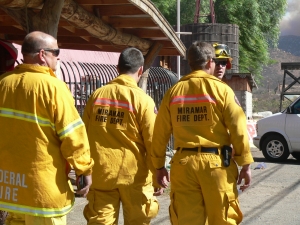 ward me.
ward me.
Already, firefighters from as far away as Miramar were on the scene, though the fire was no more than an hour or two old.
Just moments after I arrived, firefighters with bullhorns shouted evacuation orders. Someone yelled “Run for your lives.”
No one needed persuading. Even a group of Hell’s Angel bikers raced toward their motorcycles and burned rubber hauling out. 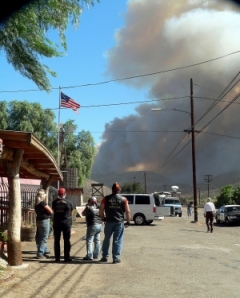
I hopped back in my car and drove north, watching in my rearview mirror as the fire consumed much of the landscape behind me in a scene straight out of hell.
That was the Harris Fire, the first of seven firestorms in San Diego County over the coming days. Collectively, these were the largest in San Diego County’s history. The 2007 firestorms here proved more destructive in size, duration and property damage than even the 2003 Cedar Fire, which up until then was the worst firestorm in California history.
Collectively, those seven fires charred 369,000 acres—around 13 percent of the county’s total landmass, according to the 2007 San Diego County Firestorms After Action Report. It destroyed over 1,600 homes and over a thousand other structures. Ten people lost their lives; 89 firefighters and 23 civilians were injured.
These fires triggered the evacuation of over half a million people—at the time, the largest evacuation for a natural disaster ever in the U.S. Three thousand animals were also rescued, though the fire had devastating impacts on wildlife, too. Firefighting costs for the four largest blazes—the Harris, Witch Creek, Rice Canyon and Poomacha fires—cost over $41 million. Total damages from all the fires were forecast to exceed $1.5 billion.
My reporting focused on the Harris Fire, which scorched a destructive swath all the way to the Otay and Sweetwater Reservoirs in the west, Campo in the east, the border to the south, and Rancho San Diego to the north. I was writing for a print weekly newspaper, which couldn’t print the news until too 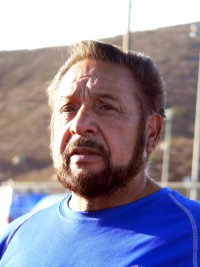 late to serve as a warning—only document what happened after the fact. After the fires, I wrote a grant to start up East County Magazine, so that our region would have a source of live news when it’s needed most, as well as an alert system to supplement others that at the time, though helpful for some, came too late or not at all for others.
late to serve as a warning—only document what happened after the fact. After the fires, I wrote a grant to start up East County Magazine, so that our region would have a source of live news when it’s needed most, as well as an alert system to supplement others that at the time, though helpful for some, came too late or not at all for others.
That first day, I interviewed evacuees in a parking lot at Steele Canyon High School, including a Hispanic man (photo, left) deeply troubled because Border Patrol agents had been sent to evacuate a trailer park where he lived. He told me that some residents who were undocumented were afraid and didn’t answer the door, so didn’t know about the fire. He went back to speak with them in Spanish and enabled many to escape safely. Some undocumented immigrants were less fortunate; several recent border crossers died, trapped when flames overtook a canyon they were in.
Another death and injury struck me hard. Thomas Varshock was killed and his 15-year-old son, Richard, was severely burned outside their home in Potrero. Firefighters also suffered injuries in the tragic incident.
On the road out while evacuating, the family met up with firefighters and urged them to save their home on a remote ridge. Thomas and Richard followed the firefighters on an ATV vehicle, which broke down. The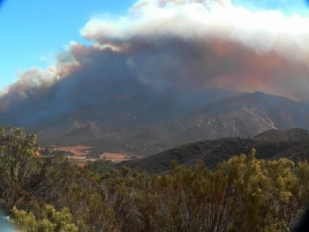 y knocked on the windows of the fire engine, and the crew let them inside. The firefighters tried to save the Varshocks’ mobile home and a shed, but the fire was too intense. As the captain tried to back the fire truck away, the engine died and the truck was engulfed in flames. Richard managed to escape, but was badly burned. His father perished in the flames.
y knocked on the windows of the fire engine, and the crew let them inside. The firefighters tried to save the Varshocks’ mobile home and a shed, but the fire was too intense. As the captain tried to back the fire truck away, the engine died and the truck was engulfed in flames. Richard managed to escape, but was badly burned. His father perished in the flames.
I knew the Varshock family; Thomas’ brother, George Varshock, had been the assistant manager of Thearle Music Company where I’d worked as a teen, and his son, George Jr. was a talented pianist who would often come in the store; we played duets together. The thought of the grief they were going through brought tears to my eyes when I heard the news.
Accounts of just what happened differ, as the Union-Tribune reported. Surviving family members filed a lawsuit against Cal Fire, but lost; a judge ruled that sovereign immunity protected the agency against tragedies that occurred as part of their duties fighting fires and attempting to rescue people.
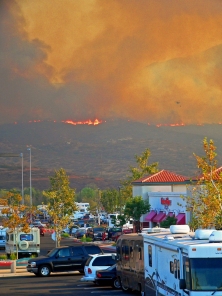 Later during the seemingly endless firestorm, evacuees were moved from the school I’d visited as flames threatened that area, too. I went to a shopping center in Rancho San Diego, where Target and Hooley’s are located. The scene was surreal – evacuees, some moved for the second or third time, parked in RVs or cars in the parking lot.
Later during the seemingly endless firestorm, evacuees were moved from the school I’d visited as flames threatened that area, too. I went to a shopping center in Rancho San Diego, where Target and Hooley’s are located. The scene was surreal – evacuees, some moved for the second or third time, parked in RVs or cars in the parking lot.
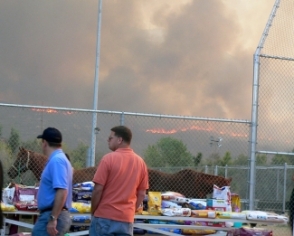 A makeshift corral with temporary fencing had been erected behind the center. Horses were being tended by volunteers. Then the fire began encroaching over the hill behind the shopping mall.
A makeshift corral with temporary fencing had been erected behind the center. Horses were being tended by volunteers. Then the fire began encroaching over the hill behind the shopping mall.
Firefighters decided to cut a fire break partway down the hill, igniting the tinder-dry brush just a short distance above. I stood transfixed and fearful, knowing that backfires can sometimes get out of control in high winds, but it was the only chance to save the center.
People stood staring, some in lawn chairs, one man with a parrot on his shoulder. The smoke was so thick and orange that it blotted out the sun. Mercifully, the firefighters’ efforts were successful.
A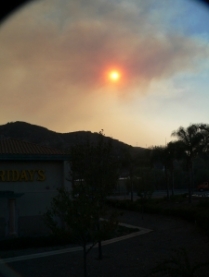 t one point evacuation orders came within two miles of my own home on the south slope of Mt. Helix. I watched with trepidation as flames glowed orange on Mt. Miguel, visible from my driveway. I drove to the top of Mt. Helix, where I shot the photo, right.
t one point evacuation orders came within two miles of my own home on the south slope of Mt. Helix. I watched with trepidation as flames glowed orange on Mt. Miguel, visible from my driveway. I drove to the top of Mt. Helix, where I shot the photo, right.
So many people ha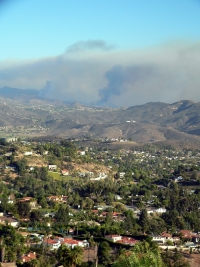 d to flee that the County eventually opened up Qualcomm Stadium to take in evacuees.
d to flee that the County eventually opened up Qualcomm Stadium to take in evacuees.
Meanwhile fires were spreading across North County, too. I called my publisher at Décor and Style Magazine in Solana Beach to cancel a meeting with the editor – only to learn that they had just been given evacuation orders. Their office was a block from the beach! Authorities feared these fires could potentially burn all the way to the sea, as fires merged to form a daunting fire wall 100 miles long.
On the second or third night of the fire, the blaze doubled back to again threaten the town of Potrero, high in the southeastern mountains of East County.
I began getting emails at midnight from people who were trapped there, pleading with me for help. Jan Hedlun, a planner I’d interviewed for a series of stories on Blackwater seeking to build a paramilitary camp in Potrero, told me their phone lines and cell phone towers had all burned down, so they had no way to get information except the internet. The County emergency site was crashed from so many people trying to access it. Flames were all around and some roads were blocked.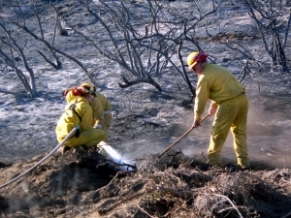
Thankfully I was able to find the information they needed and send it to them, though most chose not to leave. These rural residents were mistrustful of authorities, having lived through other wildfires where they said no fire engines ever showed up and they were left to douse burning embers themselves, saving homes.
This is very dangerous, putting lives at risk, but for some, saving a lifetime of memories seemed worth that risk. One community planner, Thell Fowler, was facing a recall election for voting for Blackwater. Yet he stayed behind and bravely saved several neighbors’ homes with a garden hose, dousing embers.
Some Potrero residents escaped the flames by standing on chairs or ladders and hopping over the border fence into Mexico –an argument against building a truly impenetrable wall. How many more would have died if a towering wall had been in place back then?
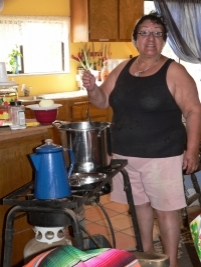 Then I got a call advising me that the site Blackwater swore could never burn, a box canyon with only one steep road in and out, was on fire. The next morning I slipped up past fire lines on a back road and documented firefighters dousing still smoldering blackened patches on the valley floor—as well as red streaks from fire retardant dropped by a massive firefighting plane during the night.
Then I got a call advising me that the site Blackwater swore could never burn, a box canyon with only one steep road in and out, was on fire. The next morning I slipped up past fire lines on a back road and documented firefighters dousing still smoldering blackened patches on the valley floor—as well as red streaks from fire retardant dropped by a massive firefighting plane during the night.
Knowing Potrero was running out of supplies and that somehow no relief agencies had come to help (wishing no doubt that residents would evacuate), I’d loaded up my trunk with water bottles, oranges from my backyard trees, diapers for infants and a few other necessities which I donated to those in need. 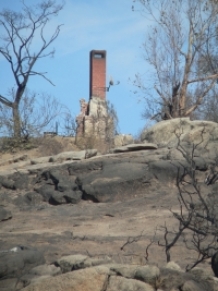
I visited a makeshift soup kitchen set up by a neighbor of Hedlun, serving up meals for the entire community (photo, left). This was a close-knit town of only about 800 residents. Some streets were buried in mounds of ashes that also filled the air, stinging eyes and prompting coughs. Some homes had burned, ghost chimneys rising like spectral fingers from the rubble.
Blackwater tried to do a good deed. The paramilitary contractor, still hoping to win hearts of Potrero residents opposed to its training camp plans, donated use of huge military tents that they set up across the street from the Barrett Junction Café—free for an evacuees who needed a safe place to stay. But when I stopped by, not a single resident had come there, too proud to take help from a company most felt was going to destroy the peace and tranquility of their town.
Just a couple of weeks after the fire, the town voted overwhelmingly to recall all five planners who voted for Blackwater’s project. Although the ultimate decision would have been up to County Supervisors, Blackwater ultimately withdrew its plans, citing high cost of noise abatement, though that had been known all along. Perhaps the vision of their planned paramilitary encampment consumed by an East County firestorm convinced them to seek a safer location.
After my visit behind fire lines to Potrero, I planned to head out on the east side through Campo, but an employee at the general store warned me not to—since a sniper had taken shots at vehicles, he said. So I drove to the roadblock on highway 94 going down to Barrett Junction – a steep, tortuous road on the best of days. A deputy at the roadblock told me the first vehicle, a CHP car, had just been allowed through. I showed my press pass and he said I could take my chances.
It was a hair-raising and heart-wrenching drive. The guardrail was gone and in places, part of the roadway had melted away. I hugged the center line and at times, drove on the wrong side. In places it was hundreds of feet, maybe thousand feet or more, to the canyon floor—with no barrier in place.
It was like driving through a moonscape. Every living thing was blackened; even the rocks were scorched. Further down, toward Dulzura, there were patches of green where the fire had hop-scotched, sparing one home, reducing another to a smoldering pile of rubble. Burned vehicles were juxtaposed against brightly colored children’s toys and the occasional live oak tree that had, somehow, been spared. 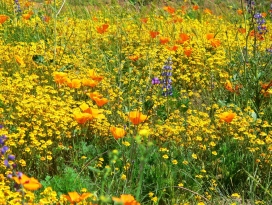
I drove that road again in spring, five or six months later, and was surprised to find fields of wildflowers abloom, including wind-born seeds blown in by the firestorm—orange poppies, blue lupines, and little yellow blossoms. Life did indeed return, as the backcountry began to recover.
But for those who lost homes, the process has been much slower; some were never able to rebuild, or chose to build new lives elsewhere. For those who lost loved ones, the wounds will never heal. Some survivors now have new homes, like proverbial Phoenixes risen from the ashes of the past, yet a whiff of smoke still sparks a visceral sense of fear.
After the fires, the hardest part of this story was interviewing people who had lost everything. I was a freelancer back then for several other publications; some of them are long gone now, and the only copies of my works gone, too. So I don’t remember all of the names, but the faces, the voices and the tears of the fire survivors I met are forever emblazoned in my memory.
One elderly woman told me the thing she regretted most was losing her wedding ring, which she’d removed to wash the dishes. She’d recently been widowed, and her home was lost to the flames. Then miraculously, a firefighter came to her and told her he’d been fighting the fire at her home, and regretted that he could not sav e it – but he did salvage one thing gleaming amid the soot and ash –her wedding ring.
e it – but he did salvage one thing gleaming amid the soot and ash –her wedding ring.
I remember kneeling in the ashes of a home lost in Ramona during the Witch Creek Fire (photo, left), as a survivor stoically searched for anything she could salvage There wasn’t much—a shard of burned pottery from her studio seemingly all that remained. Then she walked to a rose garden her late mother had planted, heirloom plants burned to ash A bittersweet smile formed as she spotted a single rosebud poking up through the ashes, reaching toward the sunlight—a divine sign, she believed, symbolizing that life goes on, hope rising from despair.
The County, Cal Fire, and other firefighting agencies have learned a great deal from those fires. It’s a testament to their good works that we haven’t had another raging infern o on the scale of those 2003 or 2007 firestorms in the past decade, though there have been smaller but still severe fires such as the Chariot Fire that torched Mount Laguna, or the Border Fire that again torched parts of Potrero. But we are seeing much better coordination and communication among multiple fire agencies, better equipment, contributions from Native American tribes, SDG&E (which Cal Fire held responsible for three of the fires) and the County.
o on the scale of those 2003 or 2007 firestorms in the past decade, though there have been smaller but still severe fires such as the Chariot Fire that torched Mount Laguna, or the Border Fire that again torched parts of Potrero. But we are seeing much better coordination and communication among multiple fire agencies, better equipment, contributions from Native American tribes, SDG&E (which Cal Fire held responsible for three of the fires) and the County.
After the fire, I visited a site near where the Harris Fire was believed to have started, off of Harris Ranch Road (photo, right). The cause of the Harris Fire, remains unknown. Power lines were ruled out; there were none at the site, though three of the other fires in the 2007 firestorms were found by state regulators to have been caused by electrical power lines and equipment.
There were many rumors, but none have ever been confirmed, and no one was ever held responsible for the Harris Fire that cost so many lives and destroyed countless dreams.










Comments
Burnt
A family my son knows lost everything, he brought me a three foot long by one to two inch wide piece of aluminum from the pistons in a hot rod car that was destroyed. The family owned a successful business and could afford to find temporary housing and rebuild.
Thank You Miriam.
George, thank you.
I hope that your family has healed and that you're doing well.
Thank You Miriam
Your story brought back vivid memories. Thank you Miriam for all you do to keep us informed. We are all better Citizens for it!